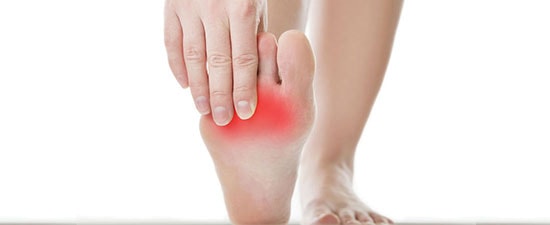- Home
- Foot & Ankle Conditions
- Metatarsalgia (ball of foot pain)
Metatarsalgia: symptoms, causes and treatments
- Published 6/1/2018
- Last Reviewed 11/20/2024

What is Metatarsalgia?
Metatarsalgia often referred to as "ball of the foot pain" or a "stone bruise" is not so much a condition but a general term describing a group of foot problems whose symptoms are caused by several conditions.
In some cases, there can be more than one condition causing metatarsalgia symptoms. This is just one of several reasons why a proper diagnosis can be challenging and why the experience of your doctor is such a critical part of diagnosis and getting a successful treatment plan from the start.
-
Foot and Ankle Surgeon at University Foot and Ankle Institute
Dr. Justin Franson, DPM, is a Board Certified Podiatric Foot and Ankle Specialist and Diplomate of the American Board of Podiatric Surgery. He attended the School College of Podiatric Medicine in Chicago, graduating in 2001. Dr. Franson then accepted a three-year residency program at the Greater Los Angeles VA and UCLA County Hospital.
Dr. Franson specializes in several areas including total ankle replacement and sports medicine. Treating athletes and weekend warriors like himself brings him a lot of joy. Dr. Franson keeps active with running marathons, triathlons, hiking, basketball, and golf.
Metatarsalgia articles from our blog
 I had a very positive experience with Dr Franson and the staff at University Foot & Ankle. I've been going for treatment and ch...Karolina N.
I had a very positive experience with Dr Franson and the staff at University Foot & Ankle. I've been going for treatment and ch...Karolina N. My experience was very good. Dr. Kelman was quick but thorough. He has a good sense of humor and is very pleasant.Isabel B.
My experience was very good. Dr. Kelman was quick but thorough. He has a good sense of humor and is very pleasant.Isabel B. I am very happy with the bunion surgery I received from Dr. Baravarian. He and his staff were outstanding. I would highly recom...Blair M.
I am very happy with the bunion surgery I received from Dr. Baravarian. He and his staff were outstanding. I would highly recom...Blair M. You were recommended by a friend and I will surely pass that to my friends shouldmany be inPhilip M.
You were recommended by a friend and I will surely pass that to my friends shouldmany be inPhilip M. He is informed,smart and current in information. Helped me a lot. Recommended Medicine for my toe nails,he cultured first and m...Theresa M.
He is informed,smart and current in information. Helped me a lot. Recommended Medicine for my toe nails,he cultured first and m...Theresa M. Would rather deal directly with the local office.Andrea G.
Would rather deal directly with the local office.Andrea G. Dr. Johnson is terrific: competent, caring, and communicative. Also, he shows he is a real human, not just filling a role of do...Sharon S.
Dr. Johnson is terrific: competent, caring, and communicative. Also, he shows he is a real human, not just filling a role of do...Sharon S. Your staff are always caring and professional.
Your staff are always caring and professional.
I like Dr Bob and Dr Gina very much.Linda T. You guys are really good over there. Okay, I love my doctor jafari. He's very knowledgeable. Makes me feel comfortable and yeah...David J.
You guys are really good over there. Okay, I love my doctor jafari. He's very knowledgeable. Makes me feel comfortable and yeah...David J. Dr Johnson was really lovely and took the time to make my young son comfortable and at ease. He was honest about not being spec...Conaill H.
Dr Johnson was really lovely and took the time to make my young son comfortable and at ease. He was honest about not being spec...Conaill H. Dr. Naei and her staff are pleasant and accommodating. Dr. Naei listens and does everything within her power to assist the pati...Carmen F.
Dr. Naei and her staff are pleasant and accommodating. Dr. Naei listens and does everything within her power to assist the pati...Carmen F. I've been seeing Dr Briskin for a few months in the treatment of plantar fasciitus. I've nearly recovered and I greatly appreci...Douglas H.
I've been seeing Dr Briskin for a few months in the treatment of plantar fasciitus. I've nearly recovered and I greatly appreci...Douglas H.



